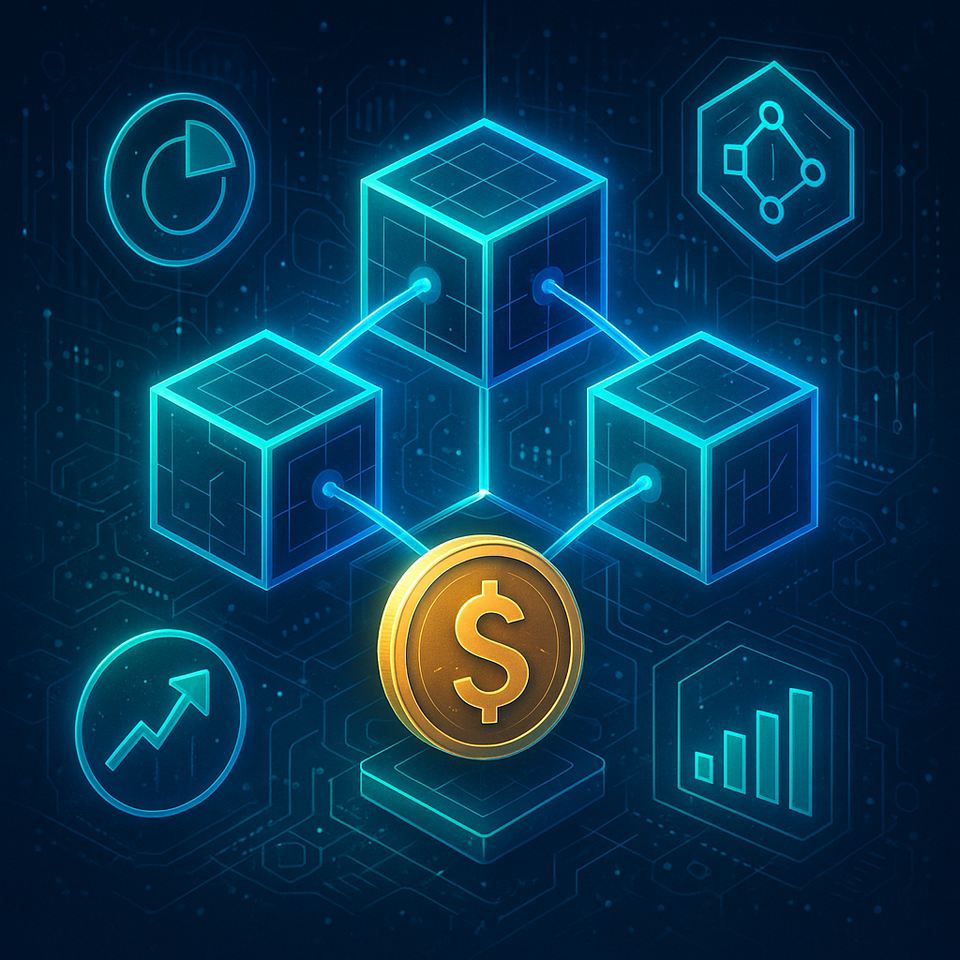
Introduction
The financial world is undergoing a profound transformation. Traditional financial systems, though established, often face challenges. These include limited accessibility, slow transaction speeds, and high fees. Many investors seek new avenues for growth and control over their assets. This desire highlights the evolving landscape of global finance. It also sparks interest in innovative financial solutions. The concept of Decentralized Finance (DeFi) emerges as a powerful answer. DeFi represents a paradigm shift. It leverages cutting-edge blockchain technology. This technology creates an open, transparent, and permissionless financial ecosystem. Understanding DeFi is crucial for anyone navigating modern investment strategies. It is also vital for those planning their financial future. This article provides a comprehensive introduction. It explores the core principles, components, and implications of DeFi. We will uncover how this technology could reshape our interactions with money.
What is Decentralized Finance (DeFi)?
Decentralized Finance (DeFi) refers to financial applications. These applications are built on blockchain technology. Most commonly, they use the Ethereum blockchain. Unlike traditional finance (TradFi), DeFi operates without central authorities. There are no banks, brokers, or exchanges acting as intermediaries. Instead, smart contracts automate transactions and agreements. These contracts are self-executing. They enforce agreements directly. This eliminates the need for trusted third parties. The core idea is to bring financial services to everyone. It aims to offer these services with greater transparency. It also promises enhanced efficiency and lower costs.
Traditional Finance vs. DeFi
Traditional finance relies on centralized institutions. Banks manage deposits and loans. Brokers facilitate investments. Insurance companies underwrite policies. These entities control access to services. They also dictate terms and conditions. Regulation is a significant aspect of TradFi. It provides a framework for stability and consumer protection. However, it can also lead to slower processes. It often involves higher fees and geographical limitations.
DeFi, conversely, is permissionless. Anyone with an internet connection can participate. There is no need for identity verification (KYC). This offers unprecedented global accessibility. Transactions occur peer-to-peer. They are governed by code, not by corporations. This model aims to reduce censorship and discrimination. It seeks to empower individuals with full control over their digital assets. This fundamental difference redefines ownership and participation.
Core Principles of DeFi
Several foundational principles underpin the DeFi ecosystem. These define its unique characteristics and potential impact. Understanding them is key to grasping DeFi’s revolutionary nature.
- Decentralization: No single entity controls the network. Decisions are often made by the community. This is achieved through governance tokens and DAOs.
- Transparency: All transactions are recorded on a public blockchain. While identities remain pseudonymous, every transaction is verifiable. This fosters an environment of trust through verifiability.
- Permissionlessness: Anyone can access and use DeFi protocols. There are no gatekeepers or approval processes. This opens financial services to underserved populations globally.
- Interoperability: Many DeFi applications are designed to work together. They can be stacked and combined like LEGO bricks. This creates complex and innovative financial products.
- Programmability: DeFi leverages smart contracts. These are self-executing pieces of code. They automate agreements and processes. This reduces human error and increases efficiency.
Key Components of the DeFi Ecosystem
The DeFi ecosystem is vast and continually expanding. It offers a diverse range of financial services. These services mirror many found in traditional finance. However, they are reimagined through a decentralized lens. Exploring these components reveals the breadth of DeFi’s potential.
Decentralized Exchanges (DEXs)
Decentralized Exchanges (DEXs) are platforms. They allow users to trade cryptocurrencies directly. They do not require an intermediary. Unlike centralized exchanges (CEXs), DEXs never hold users’ funds. This significantly reduces the risk of hacking. Users maintain custody of their digital assets at all times. Automated Market Makers (AMMs) are common in DEXs. They use liquidity pools and algorithms. These facilitate trades without traditional order books. This provides continuous liquidity for various token pairs.
- Uniswap: A leading DEX using the AMM model.
- Sushiswap: Another popular DEX with similar functionalities.
- Pancakeswap: A prominent DEX on the Binance Smart Chain.
Lending and Borrowing Protocols
DeFi lending and borrowing protocols enable peer-to-peer loans. Users can deposit their crypto holdings. These deposits earn interest. Other users can then borrow these funds. They typically provide collateral in excess of the loan value. This overcollateralization protects lenders from default. Interest rates are often determined by supply and demand algorithms. These protocols bypass banks entirely. They offer more flexibility and often better rates. This innovative approach to credit markets is transformative.
- Aave: A well-known protocol for lending and borrowing.
- Compound: Another major player in the DeFi lending space.
Stablecoins
Stablecoins are cryptocurrencies. Their value is pegged to a stable asset. This is usually the US Dollar. They aim to minimize price volatility. This makes them suitable for transactions and savings. They are essential for navigating the volatile crypto market. Stablecoins act as a bridge. They connect the traditional financial world with Decentralized Finance (DeFi). They offer a stable medium of exchange within the ecosystem. This stability is crucial for daily financial activities.
- USDT (Tether): The largest stablecoin by market capitalization.
- USDC (USD Coin): Another widely used regulated stablecoin.
- DAI: A decentralized stablecoin collateralized by crypto assets.
Yield Farming and Staking
Yield farming is a strategy. It involves leveraging various DeFi protocols. The goal is to maximize returns on crypto assets. Users move their funds between different protocols. They seek the highest possible yields. This often involves providing liquidity to DEXs. It can also include lending assets on borrowing platforms. Staking involves locking up cryptocurrencies. This supports the operation of a blockchain technology network. In return, users earn rewards. Both methods offer ways to generate passive income. However, they carry inherent risks. These include impermanent loss and smart contract vulnerabilities.
- Liquidity Provision: Earning fees by providing assets to DEX liquidity pools.
- Staking: Locking tokens to secure a Proof-of-Stake network.
- Lending: Depositing assets into lending protocols to earn interest.
Decentralized Autonomous Organizations (DAOs)
DAOs are organizations. They are run by rules encoded as smart contracts. These rules are transparent and unchangeable. Members typically hold governance tokens. These tokens grant voting rights. Decisions are made collectively by token holders. This democratic approach applies to protocol upgrades. It also applies to treasury management. DAOs represent a new model of organizational structure. They emphasize community governance and autonomy. This is a core tenet of the broader decentralization movement.
- MakerDAO: Governs the DAI stablecoin.
- Uniswap DAO: Manages the Uniswap protocol.
Benefits and Risks of DeFi
While Decentralized Finance (DeFi) presents exciting opportunities, it is not without its challenges. A balanced understanding of both benefits and risks is essential. This knowledge helps investors make informed decisions. It allows them to navigate this nascent but rapidly evolving sector. Prudent risk management is always paramount. This is especially true when dealing with innovative financial instruments. This comprehensive view aids in better financial planning.
Benefits: Accessibility, Transparency, Efficiency
DeFi offers unparalleled accessibility. It removes traditional barriers to entry. Anyone with an internet connection can participate. This global reach extends financial services to the unbanked. Transparency is another significant advantage. All transactions are immutable and publicly verifiable on the blockchain. This fosters trust and reduces fraud. Automation through smart contracts enhances efficiency. It eliminates manual processes and reduces human error. Transactions can settle much faster. This reduces costs compared to traditional systems. These benefits collectively present a compelling case for DeFi’s adoption.
- Global Access: Financial services available worldwide.
- Reduced Fees: Often lower costs due to fewer intermediaries.
- Faster Transactions: Near-instantaneous settlement times.
- Immutability: Transactions cannot be altered once recorded.
Risks: Volatility, Security, Regulatory Uncertainty, Smart Contract Risks
Despite its promise, DeFi carries substantial risks. The market is highly volatile. Prices of digital assets can fluctuate wildly. This can lead to significant losses. Security is a constant concern. Smart contract vulnerabilities can be exploited by hackers. This can result in irreversible fund losses. The regulatory landscape remains unclear. Governments worldwide are still defining how to regulate DeFi. This uncertainty poses risks for both projects and users. There is also the risk of impermanent loss in liquidity pools. Understanding these risks is crucial for any potential investor. Proper due diligence is always recommended. This helps mitigate potential negative outcomes. This informed approach is key for sound investment portfolio management.
- Market Volatility: High price fluctuations of cryptocurrencies.
- Smart Contract Bugs: Code vulnerabilities leading to potential exploits.
- Regulatory Risk: Evolving and uncertain legal frameworks.
- Impermanent Loss: A risk for liquidity providers in AMMs.
- Rug Pulls: Malicious developers abandoning a project.
Navigating the DeFi Landscape: Investment Considerations
Engaging with Decentralized Finance (DeFi) requires careful thought. It is not merely about chasing high returns. It involves understanding the underlying technology and associated risks. A strategic approach is vital for successful participation. Integrating DeFi into an investment portfolio demands prudence. It also requires a commitment to continuous learning. This section outlines key considerations for investors. These will help navigate this complex and dynamic environment. This focus on education is essential for every investor.
Research and Due Diligence
Thorough research is non-negotiable in DeFi. Before investing, study the protocol. Understand its purpose, team, and security audits. Evaluate the **blockchain technology** it uses. Review its tokenomics and community support. Look for established projects with a proven track record. Avoid projects with unrealistic promises. Always be skeptical of extremely high returns. This initial investigation can save significant losses. It empowers investors to make informed decisions. Diligence is the foundation of sound cryptocurrency investment.
- Project Whitepaper: Read and understand the project’s vision.
- Team Background: Research the experience and reputation of the developers.
- Security Audits: Verify if the smart contracts have been audited.
- Community Sentiment: Gauge public perception and support.
Portfolio Diversification
Portfolio diversification is a cornerstone of smart investing. This principle is especially critical in DeFi. Do not put all your funds into one project. Spread investments across different protocols and asset types. Consider allocating a small portion of your overall portfolio to DeFi. This approach helps manage risk. It can protect against the failure of a single asset. It also balances potential high-growth assets with more stable ones. Remember the speculative nature of many digital assets. A balanced approach is crucial for long-term financial health. This strategy is vital for comprehensive financial planning.
- Across Protocols: Invest in various DeFi applications.
- Across Asset Classes: Combine stablecoins, major cryptocurrencies, and DeFi tokens.
- Traditional Assets: Maintain exposure to traditional stocks, bonds, and real estate.
Understanding Volatility
The cryptocurrency market is known for its volatility. Prices can swing dramatically in short periods. This inherent characteristic affects all digital assets. Investors must be prepared for these fluctuations. Volatility can lead to significant gains or substantial losses. Do not invest money you cannot afford to lose. Develop a clear investment thesis. Stick to your strategy during market downturns. Emotional decisions often lead to poor outcomes. A deep understanding of market cycles is beneficial. This knowledge helps manage expectations and stress. It contributes to more resilient investment portfolio management.
- Risk Tolerance: Assess your personal comfort level with risk.
- Market Cycles: Understand bull and bear markets.
- Long-Term vs. Short-Term: Define your investment horizon.
Financial Planning in a DeFi World
Integrating DeFi into your broader financial planning requires prudence. Consider how these speculative investments fit your goals. This includes short-term savings, **retirement planning**, and wealth accumulation. DeFi assets are highly liquid but also highly risky. Therefore, they may not be suitable for core retirement funds. However, a small, well-researched allocation could enhance returns for some. Always prioritize traditional emergency funds and stable savings first. Consult with a financial advisor experienced in digital assets. They can help align DeFi investments with your overall financial picture. This holistic view ensures a balanced and secure future. Think about decentralized insurance solutions as well, though they are nascent.
- Emergency Fund: Secure traditional savings first.
- Retirement Accounts: Exercise caution with highly volatile assets.
- Estate Planning: Consider how **digital assets** will be handled.
- Tax Implications: Understand reporting requirements for crypto gains.
The Future Outlook for DeFi
The journey of Decentralized Finance (DeFi) is still in its early stages. Yet, its potential to revolutionize global finance is undeniable. The ecosystem is rapidly evolving. Innovations are constantly emerging. These developments aim to address current limitations. They also seek to expand DeFi’s reach and utility. The future promises a more integrated and accessible financial landscape. This evolving environment will reshape how we interact with money. It offers new opportunities for financial freedom and growth. The sustained growth of **blockchain technology** will fuel this progress.
Interoperability and Scalability
Current DeFi protocols often operate in silos. They are largely confined to their native blockchains. Future developments will focus on interoperability. This means different blockchains will communicate seamlessly. Projects like Polkadot and Cosmos are building bridges. These bridges will allow assets and data to flow freely. Scalability is another critical area of focus. High transaction fees and network congestion are common issues. Layer 2 solutions and new consensus mechanisms aim to solve this. These improvements will make DeFi faster and more cost-effective. They are essential for broader adoption.
- Cross-Chain Bridges: Connecting disparate blockchain networks.
- Layer 2 Solutions: Scaling networks like Polygon and Arbitrum.
- Sharding: Dividing a blockchain into smaller, manageable pieces.
Mainstream Adoption
For DeFi to truly fulfill its promise, mainstream adoption is necessary. This requires simpler user interfaces and enhanced security. Education plays a vital role in this transition. New users need clear, understandable guides. They also need reliable support. As DeFi becomes more user-friendly, its appeal will broaden. Businesses and traditional financial institutions might integrate DeFi components. This blending of TradFi and DeFi could create hybrid models. Such integration could onboard millions of new users. It represents a significant step towards a truly inclusive financial system.
- User-Friendly Interfaces: Simplifying complex DeFi interactions.
- Educational Resources: Bridging the knowledge gap for new users.
- Institutional Involvement: Increased participation from large firms.
Regulatory Evolution
The regulatory environment for Decentralized Finance (DeFi) is still maturing. Clarity from regulators will be crucial for its growth. Governments are exploring frameworks. These frameworks aim to protect consumers and prevent illicit activities. Responsible regulation could foster innovation. It could also provide legitimacy to the sector. However, overly restrictive rules could stifle progress. The balance between innovation and protection is delicate. A collaborative approach between regulators and innovators is ideal. This would ensure a safe yet dynamic financial future. The evolution of policy will significantly shape DeFi’s trajectory.
- Consumer Protection: Safeguarding users from scams and exploits.
- Anti-Money Laundering (AML): Preventing illicit financial flows.
- Taxation: Clear guidelines for reporting **digital assets**.
Conclusion
Decentralized Finance (DeFi) represents a powerful wave of innovation. It seeks to redefine how we interact with money and financial services. By leveraging blockchain technology and smart contracts, DeFi offers accessibility and transparency. It promises a more efficient and equitable financial system. From decentralized exchanges to lending protocols and stablecoins, its ecosystem is diverse. It provides numerous avenues for engagement. However, navigating this space demands careful consideration. Understanding the inherent risks, such as volatility and security challenges, is paramount. Diligent research and strategic portfolio diversification are essential. They protect investors in this dynamic environment. As DeFi matures, its potential to integrate with traditional finance grows. It offers new possibilities for personal financial planning and global economic participation. The future of money is becoming increasingly decentralized. Staying informed and approaching DeFi with a balanced perspective will be key. This will unlock its vast potential responsibly.


